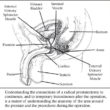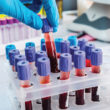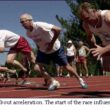Radiation After a Radical Prostatectomy
This article is adapted by Cecilia Lacks, PhD, for Quest from two * journal articles on the topic of salvage radiotherapy vs. observation in men who have had a recurrence after a radical prostatectomy as indicated by a detectable and rising PSA. The studies upon which these articles are based, one sponsored by the Urological Research Foundation and one from Johns Hopkins, are preliminary findings with limited populations and more research is needed to confirm the results.
Despite the fact that early detection of prostate cancer is much improved since the era of prostate-specific antigen (PSA) testing, a considerable number of patients have adverse findings in their final pathology reports on their prostatectomy specimens. Although adverse pathology findings clearly are associated with worse outcomes, the appropriate selection of patients for postoperative radiation therapy (RT) is an unresolved issue for treating doctors.
Randomized trials have shown an improvement in progression-free survival rates with adjuvant radiation therapy (ART). This treatment takes place soon, within 2 to 4 months, after a radical prostatectomy for patients with a high risk of cancer recurrence.
Less is known about the relative advantages and disadvantages of initial observation with delayed salvage radiation therapy (SRT). This treatment takes place some time after a radical prostatectomy but only when there is evidence from a rising or detectable PSA that indicates a recurrence. SRT is local radiation to the prostate bed alone (the area around where the prostate was located before surgery). SRT is sometimes combined with hormonal therapy, for example, in patients with a high Gleason-grade tumor.
Despite studies supporting the use of immediate adjuvant radiotherapy for men with unfavorable pathology in their RP specimens; the treatment may lead to additional side effects that can create treatment complications and affect quality of life. In addition, it’s possible that a proportion of men could be overtreated, for example, by receiving radiation treatment unnecessarily.
As a result, some physicians instead prefer initial observation with later salvage radiation therapy at the time when there is evidence of recurrence.
The purpose of these studies was to examine the results of initial observation followed by SRT in patients with adverse pathology and in patients with cancer recurrence as indicated by a detectable and rising PSA.
The appropriate management for men with adverse pathology at the time of RP is controversial. Some patients with minimal adverse pathology may have a low progression rate without additional treatment.
On the other end of the spectrum, some patients with high-risk features likely may have cancer that has already spread and will not benefit from additional local therapy.
The issue is to define the intermediate group of patients who will truly benefit from postoperative radiation and to know the best time for beginning treatment.
Study Connected to SM+ and ECE
The adverse pathology in radical prostatectomy patients from one study (Loeb 2008) falls into the following categories: Positive surgical margins (SM+), extracapsular tumor extension (ECE) and seminal vesicle invasion (SVI).
This study found that initial observation followed by delayed SRT at the time of PSA recurrence might be an effective strategy for select patients with positive surgical margins and extracapsular tumor extension.
Timing of SRT is an important factor in effective results. Those patients who began SRT when their PSA levels were less than 1 had much better results than those who waited until PSA levels were more than 1.
Some patients with seminal vesicle invasion may also benefit; however, additional studies are necessary to examine survival outcomes following SRT in these patients because the study found that patients with SVI had a significantly higher progression rate with observation alone.
Study Connected to PSA Doubling Time
Cancer recurrence after radical prostatectomy often results in a recommendation for salvage radiation. This study (Trock, 2008) examined whether salvage radiation confers a survival benefit compared with observation.
The research looked at survival statistics for men who were treated with salvage radiation after recurrence to see if some men had a significant increase in survival after treatment with salvage radiation and some men showed less or no effect.
What the study found is that men with a PSA doubling time of less than six months after recurrence benefited most from salvage radiation. In contrast, salvage radiotherapy has not yet been shown to be significantly associated with prostate cancer-specific survival among men with a PSA doubling time of 6 months or longer.
Possibly, the men with slower doubling times have less aggressive cancers with less need for salvage radiation. But it is also possible, and even likely, that with longer follow-up, men with slower PSA doubling times will be shown to receive a survival advantage from SRT as well.
In their article, researchers said, “This study provides provocative evidence that even men with adverse prognostic features such as rapid PSA doubling time or high Gleason score may benefit from salvage radiotherapy”.
Before this study, the prevailing theory was that recurrence was evidence the cancer had metastasized in some other place or places in the body. This finding, they said, “If true, has somewhat surprising implications for the prevalence of local recurrence as a source of PSA relapse”.
Additional findings suggested that men for whom salvage radiotherapy is most beneficial are those with a PSA doubling time of less than 6 months, who also undergo treatment within 2 years of an increase in PSA level and before the PSA reaches 2.
More Research Will Help Make Decisions
The findings in these studies are preliminary. Clearly, additional studies with more detailed information on pathologic features would be helpful to further evaluate the effectiveness of treatment for a patient who has adverse findings on his final pathology report from his radical prostatectomy specimen.
Options now include:
- Doing nothing other than monitoring PSA and having salvage radiation or hormonal therapy if the PSA rises.
- Having adjuvant radiation (with or without hormones).
- Having adjuvant hormonal therapy alone.
- Having experimental chemotherapy (with or without hormonal therapy).
For most patients, the decision (if they are having radiotherapy) is adjuvant vs. delayed salvage radiation. But, in some instances, the other options are recommended.
“Based upon these studies, it cannot be said that salvage radiation is as good as adjuvant, and it can’t be said that some patients with other adverse features might not also benefit from salvage, if the follow-up were longer,” Dr. William J. Catalona said.
He explained further, “What can be said is that salvage RT has a survival benefit for some patients and, that at the present time, those with the most aggressive features seem to benefit the most”.
If doctors knew which patients with adverse pathology could safely be observed after their RRP, rather than treated soon after with ART or with SRT upon recurrence, the side effects of radiation – which can create quality of life issues and possible future medical concerns – could be minimized.
*Long –Term Rates of Undetectable PSA with Initial Observation and Delayed Salvage Radiotherapy After Radical Prostatectomy, April 2008, European Association of Urology
Stacy Loeb, MD; Kimberly A. Roehl, MPH; Davis P. Viprakasit, MD; & William J. Catalona, MD. based upon a study of select radical prostatectomy patients (Dr. Catalona).
*Prostate Cancer-Specific Survival Following Salvage Radiotherapy vs. Observation in Men With Biochemical Recurrence After Radical Prostatectomy, June 2008, JAMA.
Bruce J. Trock, PhD, Misop Han, MD, Stephen J. Freedland, MD, Elizabeth B. Humphreys, MS, Theordore L. DeWeese, MD, Alan W. Partin, MD, PhD & Patrick C. Walsh, MD











